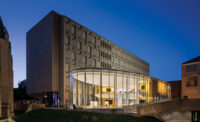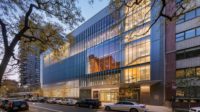Hamarøy, Norway
Steven Holl made his first sketches for the Knut Hamsun Center, in the municipality of Hamarøy, Norway, in 1994. But it was not until 2008, 14 years later, that construction started. During this long gestation period the building entered the collective consciousness to the point that it was as if it really existed — it is said that tourists ventured to the site to find no building at all. Seventeen years on, the center is complete, installed, and is being used for its intended purposes. But it’s what has happened in the intervening years, since Holl’s first visit, that has shaped the building into the important cultural center it is today.
The physical journey to Hamarøy, 125 miles north of the Arctic Circle, is also arduous. The passage, involving hours of air, sea, and road travel through breathtaking scenery, is a singular one. And the arrival to this awe-inspiring place, with its wooded hills leading down to the water’s edge and its sharp mountainous backdrop, is deeply rewarding. An obvious response to the natural beauty would be to make a humble gesture with a quiet building. However, the challenge of designing a museum dedicated to one person is that it must not simply serve as a vessel for objects, but also evoke the spirit of that person and his work. Knut Hamsun is a troubled figure in the Norwegian memory. A modernist author who won the Nobel Prize in Literature in 1920, he was celebrated as a hero. But in his later years he sympathized with Hitler, provoking national feelings of betrayal. On Holl’s first site visit he made a series of sketches. “It was a kind of project that comes to you all at once, almost like an intuition,” he says. Envisioning a tower in the forest, Holl based his ideas on the author’s first four novels and developed the concept for the center as “Building as a Body: Battleground of Invisible Forces,” a reference to Hamsun’s 1890 novel, Hunger, which chronicles a starving man’s descent into madness. With this project the architect was interested in depicting all dimensions of the author (who himself wrote about human imperfection) — both his unfettered creativity and his profound weakness.
Indeed, actual conflict started brewing the moment the head of Cultural Affairs in Nordland County contacted Holl, who was working on the Kiasma museum in Helsinki, to create drawings to help launch the project. “In a way it was a very naïve and spontaneous series of events,” recounts Holl (who has Norwegian roots). First was the opposition to erecting a monument to this controversial figure. Additionally, some considered the proposed site next to Hamsun’s childhood farmstead too sensitive. There were questions about spending large sums in an area with a population of only about 2,000, and whether the building was in sync with Hamsun’s connection to nature and Norwegian tradition. And then there was concern over the design’s “weirdness” factor. The Norwegian press went wild. The attention caused a Hamsun Center frenzy — schoolchildren asked to depict local architecture drew the building, and a tavern installed a tap in its form.
But internationally the museum was widely praised; in 1996 MoMA acquired a model, and in 1997 Holl received a Progressive Architecture award for it. Soon after, the County Council accepted a new proposal from Holl that included moving the site to the hamlet of Presteid, where the young Hamsun had worked with his uncle, and adding a low, horizontal auditorium. It took another 10 years to secure financing from the government, but when the project was revived, Holl and his team were brought back. “I always say architecture is about the site, circumstance, and program,” the architect says. “It’s not about fashion and trend. So I was excited that nothing really was changed from the time these sketches were made until the time we opened the building. The idea-driven design held well and stayed fresh. It still has that kind of energy that is particular to the place and to that literary figure.”
The 27,000-square-foot center, like Hamsun’s writings, has a quirky humor, as well as human qualities. At its most literal, it is a stout little man with an elevator shaft spine of perforated brass, a skin of stained wood, and a jaunty flattop of bamboo “hair.” It is essentially a concrete shear-wall tube (a parallelogram in plan) that supports thin, post-tensioned slab floors and is clad with black wood, inspired by traditional Norse stave churches. Drawing again from the vernacular, and completing the anthropomorphic form, the architect created an expressive interpretation of a sod roof by making the “fringe” at the top. Inside, two white, board-formed concrete walls slope just enough to make you sense something is not quite right, and winding circulation is interrupted by surprise encounters with “invisible forces” — balconies and other elements — that puncture the torqued body, pulling you outside. It’s a tour through a somber funhouse. The experience is destabilizing, notes museum director Bodil Børset. “It puts us in an awkward position, which is what Hamsun does with his books, and it speaks to the tensions within the author himself.”
In recent years there has been a national drive to preserve culture in Norway, particularly in some of the country’s remote regions that have been experiencing depopulation. The government offers financial incentives for settling in some places. And design has played an important role: 18 National Tourist Routes are being developed to showcase art and architecture against backdrops of stunning natural beauty. The museum, which was hard to realize and is hard to reach, has a goal of 20,000 visitors a year. Clearly, it is not a commercial enterprise or a mass experience (though it has been gaining more widespread acceptance, most recently by winning Norway’s prestigious Byggeskikk Prize for architecture on June 7). In all its incarnations over the last 17 years — as a controversial idea, provocative architecture, an installed museum, a community center, and a catalyst for helping the country come to terms with the national trauma that was Hamsun — the center has woven itself into the regional identity, and has served as a conduit for defining and preserving the local heritage. Tellingly, when the project began there wasn’t a written program per se — it developed as the community inserted itself into the process, says the architect. “The thing became much more than it started out being,” says Holl. The building took hold of the community and then the community took hold of it.
Total construction cost: $11 million
Completion date: August 2009
Size: 27,000 sq. ft.
Architect:
Steven Holl Architects
Steven Holl (design architect)
PeopleClient: Nordland Fylkeskommune Architect Project team construction document phase: Noah Yaffe (associate in charge), Francesco Bartolozzi, Ebbie Wisecarver, Peter Englaender Project team design development phase: Erik Fenstad Langdalen (project architect), Gabriela Barman-Kraemer, Yoh Hanaoka, Justin Korhammer, Anna Müller, Audra Tuskes Associate architects (construction document phase): LY Arkitekter AS Associate architect (design development): Askim Lantto Arkitekter AS Landscape architect (construction documents): Landskapsfabikken, Ellen Husaas, Aaste Gulden Consultants design development phase: Structural engineer (Norway): Byggcon AS Mechanical engineer (USA): Ove Arup Mechanical engineer (Norway): Geir Høyem AS Electrical engineer: Ingeniørtjeneste AS Lighting designer: L’Observatoire International Consultants construction documents phase: Site engineering: Norconsult AS Lighting designer: Vesa Honkonen Architects Project manager Nordland Fylkeskommune: Bjørn Håvard Stamnes / Per Vasshaug Site manager: Norconsult AS Bodø, Tor Berg Project manager exhibition: Nina Frang Høyum Exhibition design: Hybris Produksjon AS BUILDERS: Building envelope, interiors: Veidekke AS Ventilation: Harstad Luftteknikk AS Electrical: Haneseth AS Plumbing: Ole Nesjøe Elevator: Schindler Heis AS Alarm and signal systems: Siemens Site work: Elvenes Door and window fittings: Bodø sikkerhet & lås AS Glass-system: Fasade Nord AS Glass, special fitted: Fauske glass Steel: Galvano Sheet metal: Fauske Blikk AS |
ProductsWindows Wood: Svenneby sag Stålarbeider: Galvano Doors Wood doors: Skallevold trevare Brass: Astrup AS Furnishings Interior finishes Acoustical boards: Cembrit Conveyance |






















